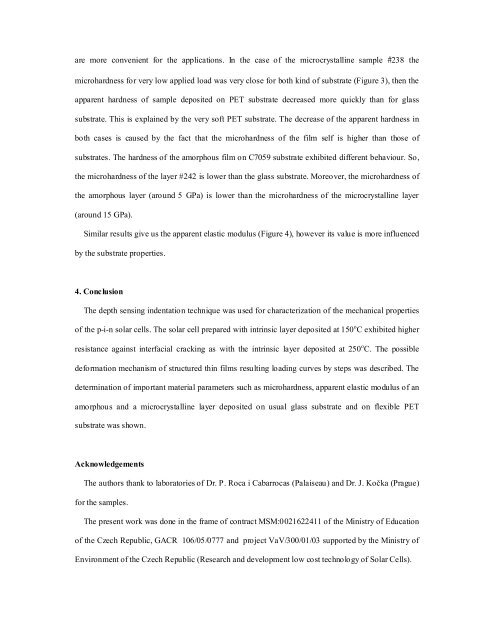Elsevier Editorial System(tm) for Journal of Non-Crystalline ... - Amper
Elsevier Editorial System(tm) for Journal of Non-Crystalline ... - Amper
Elsevier Editorial System(tm) for Journal of Non-Crystalline ... - Amper
You also want an ePaper? Increase the reach of your titles
YUMPU automatically turns print PDFs into web optimized ePapers that Google loves.
are more convenient <strong>for</strong> the applications. In the case <strong>of</strong> the microcrystalline sample #238 the<br />
microhardness <strong>for</strong> very low applied load was very close <strong>for</strong> both kind <strong>of</strong> substrate (Figure 3), then the<br />
apparent hardness <strong>of</strong> sample deposited on PET substrate decreased more quickly than <strong>for</strong> glass<br />
substrate. This is explained by the very s<strong>of</strong>t PET substrate. The decrease <strong>of</strong> the apparent hardness in<br />
both cases is caused by the fact that the microhardness <strong>of</strong> the film self is higher than those <strong>of</strong><br />
substrates. The hardness <strong>of</strong> the amorphous film on C7059 substrate exhibited different behaviour. So,<br />
the microhardness <strong>of</strong> the layer #242 is lower than the glass substrate. Moreover, the microhardness <strong>of</strong><br />
the amorphous layer (around 5 GPa) is lower than the microhardness <strong>of</strong> the microcrystalline layer<br />
(around 15 GPa).<br />
Similar results give us the apparent elastic modulus (Figure 4), however its value is more influenced<br />
by the substrate properties.<br />
4. Conclusion<br />
The depth sensing indentation technique was used <strong>for</strong> characterization <strong>of</strong> the mechanical properties<br />
<strong>of</strong> the p-i-n solar cells. The solar cell prepared with intrinsic layer deposited at 150 o C exhibited higher<br />
resistance against interfacial cracking as with the intrinsic layer deposited at 250 o C. The possible<br />
de<strong>for</strong>mation mechanism <strong>of</strong> structured thin films resulting loading curves by steps was described. The<br />
determination <strong>of</strong> important material parameters such as microhardness, apparent elastic modulus <strong>of</strong> an<br />
amorphous and a microcrystalline layer deposited on usual glass substrate and on flexible PET<br />
substrate was shown.<br />
Acknowledgements<br />
The authors thank to laboratories <strong>of</strong> Dr. P. Roca i Cabarrocas (Palaiseau) and Dr. J. Kočka (Prague)<br />
<strong>for</strong> the samples.<br />
The present work was done in the frame <strong>of</strong> contract MSM:0021622411 <strong>of</strong> the Ministry <strong>of</strong> Education<br />
<strong>of</strong> the Czech Republic, GACR 106/05/0777 and project VaV/300/01/03 supported by the Ministry <strong>of</strong><br />
Environment <strong>of</strong> the Czech Republic (Research and development low cost technology <strong>of</strong> Solar Cells).
















